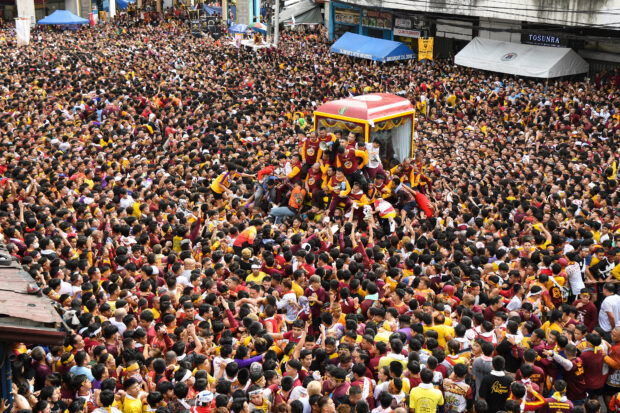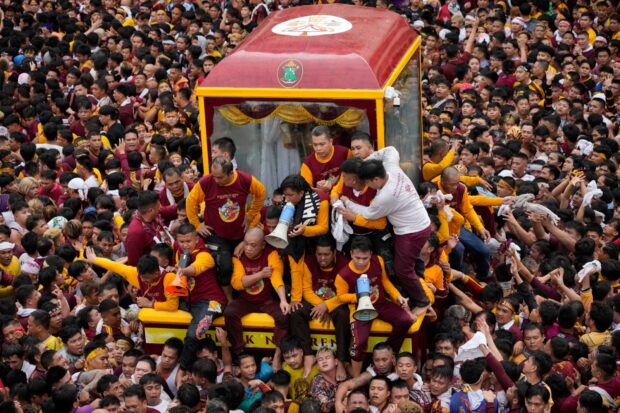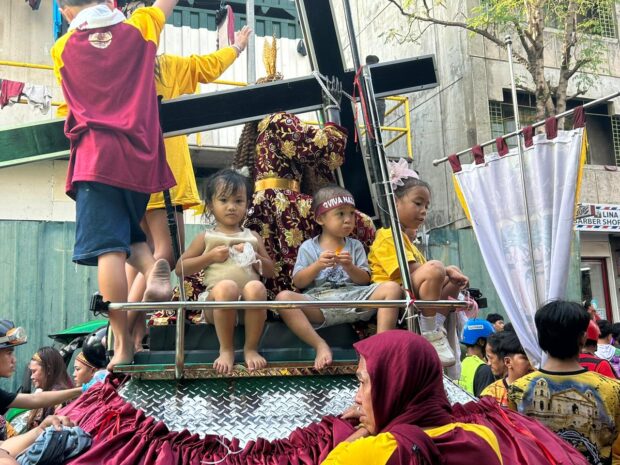6.5 million Catholics join Black Nazarene procession

Catholic devotees jostle with each other as they try to touch a glass-covered carriage carrying the so-called Black Nazarene during an annual religious procession in Manila on January 9, 2024. (AFP)
MANILA, Philippines–Around 6.5 million Catholic devotees turned up for this year’s procession to honor the Black Nazarene, turning the streets of Manila into a sea of maroon and yellow, in one of the world’s biggest displays of religious devotion.
The 15-hour procession began at 4:45 a.m. following an outdoor mass at the Quirino Grandstand in Manila and concluded at 7:45 p.m. when the life-size statue of a dark-skinned Jesus Christ returned to the Minor Basilica of the Black Nazarene in Quiapo.
The Black Nazarene, believed by many Filipinos to possess miraculous healing abilities, draws crowds seeking to touch it or the ropes on its float for cures and good fortune.
“I believe that the Nazarene will give what we are all praying for — we just have to wait, but he will give everything,” said Renelinda de Leon, 64, at the procession’s start.
Article continues after this advertisement“He gave me good health. I don’t have an illness, I’m always healthy.”
Article continues after this advertisementAs a drizzle covered the crowd, some barefoot devotees clambered over others and grabbed guards’ clothes to reach the float, leading to falls.
Other guards on the float pushed unruly followers to the ground to protect the icon, encased in glass, allowing the parade to proceed.
Over 15,000 security and medical staff were deployed along the route.
Religious vow
John Nazareth celebrated his twelfth birth anniversary on Tuesday by holding onto the metal pole of a parked fire truck at Casal Street in Manila, trying not to get swept by a throng of devotees.
“I just want to thank Him,” the young devotee said. “This is my religious vow.”
John, dressed in a yellow Nazareno shirt, used a thin towel over his head to shield from the light rain. Unfazed by the potential of falling ill, he viewed the rain as a blessing.
Zairen Advincula, 20, experienced the procession for the first time.
“It’s very crowded and exhausting,” he said, keeping close to his friends to avoid separation. Close to the ‘andas’ carrying the Black Nazarene, Zairen was seen guarding a replica image.
Acknowledging the exhaustive nature of the procession, Zairen prioritized tradition over his well-being. “My father used to do this [procession], but now he is abroad. I’m just continuing the tradition,” he said.
Zairen, sharing his birthday with John Nazareth, viewed his participation as a form of devotion.
Behind Zairen was 24-year-old Ranzelle Brao, also in his first Traslacion at Quiapo. An altar server at Santa Isabel Parish Church in Malolos, Bulacan, along with Zairen, Ranzelle expressed a commitment to serving the Father.
“As altar servers, this is our religious duty,” he said.
The barefoot youth sought strength and protection for their parents from the Black Nazarene.
“We wish for our parents to live longer so that we can be with them for a long time,” Ranzelle said, planning to join the procession until it reached Quiapo Church.
Families participated, with fathers lifting children on shoulders and mothers shielding them from the rain.
First after the pandemic
This is the first traditional parade featuring the life-size statue since 2020, paused due to Covid-19.
The Quiapo Church Command Center reported that 657,000 devotees initially joined the religious procession at the Quirino Grandstand. The crowd increased to 833,000 by 7:44 a.m., and further swelled to 1,340,000 a few hours later.
Jonathan Rancho, 52, joined with his family from Bulacan province.
“I am very pleased the old system is back and we get to do this again,” he said, hoping for improved livelihoods and success.
Marites Rote credited the Black Nazarene with curing her children’s skin rashes nearly 40 years ago and more recently, helping pay her husband’s medical bills.
“When my husband got sick we were penniless, but because of the Nazarene we were able to provide for his needs,” Rote, 60, said.
Authorities, citing no specific threat, blocked mobile signals to prevent remote detonations. They also imposed a no-fly and no-sail zone in the areas surrounding the Quirino Grandstand and Quiapo Church, Pasig River, as well as along the procession routes, from January 7 to 10.
The Traslacion, previously taking up to 22 hours, saw over 640 devotees receive medical help as of 6 p.m., the Philippine Red Cross reported. First-aid stations treated 214 people for minor medical issues, and addressing six cases with major issues.
Some devotees collapsed and were carried out or passed over others’ heads. Thirty-two individuals required transport to nearby hospitals and medical facilities.

Devotees react as they try to block others from climbing on the glass-covered cart carrying Black Nazarene. (AP)
Glass case
This year, the icon was placed in a glass case, and getting on the float was banned. Yet, some tried to touch the glass for miracles.
Gerard Cordial, a long-time devotee, expressed surprise at seeing the Black Nazarene encased in glass for the first time.
“We were shocked because we’re not used to seeing Him behind glass. We’re used to touching Him. Back then, we even had access to His face,” Cordial said.
He acknowledged, however, that the glass surrounding the sacred image significantly enhances participant safety.
“It’s for safety so that the flow of Traslacion would be better. I think it’s better this year. The procession was smoother,” he noted.
During the parade, one of two ropes pulling the float snapped.
The incident occurred at the corner of Arlegui Street and Quezon Boulevard in Manila. An officer of the Manila Public Information Office said the rope became entangled in the carriage’s axle, leading devotees to cut it.
“The rope which snapped has been brought back to Quiapo Church,” Silgen Cabrito, Quiapo Church Communications Coordinator, confirmed to reporters.
Hours later, Cabrito clarified that two ropes were still being used in the procession, but the left side was shortened after being deliberately cut.
This isn’t the first time a rope broke during the Traslacion, as similar incidents have disrupted past processions.
Tonton Ruz, a guard, told Agence France-Presse he was glad the parade resumed but hoped for more peace than before.
“Before, you can’t see him (the statue) with so many people on top of the float blocking the view,” said Ruz, 36.
‘Caridad’
While millions of devotees showed their devotion to the Black Nazarene through participation in its procession, a group of friends opted to express their gratitude for prayers answered by distributing “blessings.”
Flordeliza Burla, 54, and Raquel Navales, 53, have been engaging in “caridad,” or the act of distributing food to devotees, since 2019. Both have been followers of the Nazarene since childhood.
“Both of our hearts are full whenever we do this,” Burla said in an interview with INQUIRER.net near Quiapo Church on Tuesday.
“We are doing this because we have to return the continuous blessings we received from our Lord,” she added.
Burla and Navales ordered several hundred burgers and hotdog sandwiches, which they distributed to devotees, mostly young barefoot males wearing maroon shirts, passing by Quiapo Church after the procession.
Exhausted and hungry from the lengthy procession, the devotees gratefully accepted the refreshments.
“It’s better to give than to ask for something,” Navales also told INQUIRER.net.

Children sit beside a replica of the Black Nazarene during Traslacion 2024. (Faith Argosino/INQUIRER.net)
‘Dungaw’
The Black Nazarene’s image reached Plaza del Carmen, adjacent to the Minor Basilica of San Sebastian, at 2:52 p.m., marking a significant moment in the procession for the traditional “dungaw (look).”
After over 10 hours of procession, the image of Our Lady of Mt. Carmel de San Sebastian greeted the Black Nazarene to the enthusiastic cheers of “Viva” from devotees.
Nuestra Señora del Carmen de San Sebastian’s image was positioned on a stage adjoining the church, enabling her to meet her son from the church’s balcony.
Devotees engaged in a five-minute prayer and sang “Our Father” during this interlude.
The “dungaw” represented the only stop throughout the entire procession, a practice revived in the 2014 Traslacion. This year’s occurrence was notably earlier than in 2020, when the Black Nazarene’s image arrived at San Sebastian Church around 4:30 p.m.
Thousands of police maintained order as many devotees attempted to board the carriage.
The statue’s black color, carved in Mexico and brought to the Philippines in the early 17th century, remains a mystery. The original wooden statue is believed to have darkened after surviving a fire on a ship from Mexico.
Msgr. Sabino Vengco suggested it’s made of mesquite wood.
About 80 percent of the Philippines’ 110 million people are Roman Catholic, a Spanish colonial legacy.